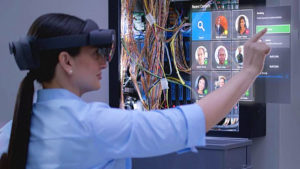Microsoft, largely considered the market leader in augmented reality (AR) aka Mixed Reality (MR), announced the long-awaited successor to the HoloLens, the HoloLens 2. Here at Loup, we are firm believers in augmented reality as the next major computing platform – one that will bring the flat digital world, as we experience it today through screens, to life in the physical world. An interface built for people first, not devices for humans to use.

We won’t get into specs here, as there are already many great articles summarizing those like these from The Verge and CNET. Here are our key takeaways from Microsoft’s MWC event in Barcelona on Sunday.
Enterprises Now, Consumers When Ready
With the HoloLens 2, Microsoft has now made it clear that it doesn’t believe augmented reality glasses are ready to be a consumer product. Their website headline even reads “Mixed reality is ready for business.” After showing off games and other consumer use cases for the initial launch of HoloLens, Microsoft focused almost all of its time on bringing out business partners to showcase how the HoloLens 2 would actually be a useful tool to their company’s employees in its current form.
Microsoft’s mission statement is “to empower every person and every organization on the planet to achieve more” so it’s not a surprise this is where the company is placing its bets for AR/MR in the near term at least.
Apple, Google, Facebook, and Magic Leap are more consumer-facing companies rumored or known to be working on AR glasses. The consumer market is not being left behind, rather before smart glasses can go mainstream, major advancements need to be made in AR tech which is why we don’t expect to see these devices released before 2021 at the earliest.
Magic Leap and Non-FANG Players Will Have a Tough Time Competing in the Near-Term
It’s been a rough few months for the AR market with the recent collapses of AR pioneers ODG, Meta, and Blippar. In the hardware market, it is clear that augmented reality glasses are not ready to be successful consumer products. It will be a few years before AR tech improves, prices become affordable, and use cases are compelling enough to go mainstream.
Big Tech is and will be spending billions in the AR arms race. There are few companies in the world with the luxury to invest that much capital into AR R&D and not require much of an ROI for years. Magic Leap has raised over $2 billion to date but could have a difficult time staying afloat without another cash infusion. Magic Leap was largely positioned for the consumer market and is likely not seeing great sales numbers it would need to keep pace with Big Tech investing billions themselves.
We are still billions of dollars and years away from where AR needs to be to gain widespread adoption. Smaller players, especially in hardware, will have a very difficult time competing with Microsoft on the enterprise side all while the consumer side practically doesn’t exist yet. Building compelling use cases for existing hardware or developing new technology along some level of the AR stack will likely be the path towards success for AR/MR startups and smaller companies.
Advancements Keep Us Bullish Long-Term
After Magic Leap stole the spotlight last year, Microsoft has reclaimed its position as the king of augmented/mixed reality. Their advancements made over the past three years give us reason to believe timetables for the development of the next-generation lineup of AR hardware from Apple, Google, Facebook and others are on track and reasonable.
In just three years, HoloLens more than doubled its field of view (HoloLens 1’s biggest issue), made the headset “3x more comfortable”, and greatly improved upon the ways users can interact with holograms using computer vision and artificial intelligence. Microsoft was able to accomplish all of this all while dropping the price from $5000 to $3500.
Alex Kipman and Microsoft continue to push the envelope on AR/MR technology, and events like MWC 2019 that showcase these breakthroughs will only motivate the Apple, Google, Facebook, Magic Leap, and others to continue investing more in the battle to become the next Apple of smart glasses.
Disclaimer: We actively write about the themes in which we invest or may invest: virtual reality, augmented reality, artificial intelligence, and robotics. From time to time, we may write about companies that are in our portfolio. As managers of the portfolio, we may earn carried interest, management fees or other compensation from such portfolio. Content on this site including opinions on specific themes in technology, market estimates, and estimates and commentary regarding publicly traded or private companies is not intended for use in making any investment decisions and provided solely for informational purposes. We hold no obligation to update any of our projections and the content on this site should not be relied upon. We express no warranties about any estimates or opinions we make.
